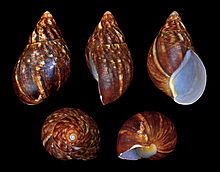- Achatina achatina
-
See also: Giant African land snail, Achatina fulica, and Archachatina marginata
Achatina achatina 
Five views of a shell of Achatina achatina Scientific classification Kingdom: Animalia Phylum: Mollusca Class: Gastropoda (unranked): clade Heterobranchia clade Euthyneura
clade Panpulmonata
clade Eupulmonata
clade Stylommatophora
informal group SigmurethraSuperfamily: Achatinoidea Family: Achatinidae Subfamily: Achatininae Genus: Achatina Species: A. achatina Binomial name Achatina achatina
(Linnaeus, 1758)Achatina achatina, common name the giant Ghana snail, also known as the giant tiger land snail, is a species of very large, air-breathing land snail, or more technically a terrestrial pulmonate gastropod mollusk in the family Achatinidae. The name 'Achatina' is from 'achates', Greek for agate.[1]
Contents
Distribution
The species is believed to be native to West Africa, within 100–190 miles of the coasts of Sierra Leone, Liberia, Ivory Coast, Togo, Benin, Ghana, and Nigeria.
Achatina achatina has as yet not been found outside of Africa, but is routinely confiscated "by Quarantine Authorities at US airports, especially Baltimore, Dulles, JFKIA, and San Francisco."[2] These very large snails are kept as pets in the Western world, where owners prize their large size, distinctive markings, and rarity.[3]
This species has not yet become established in the USA, but it is considered to represent a potentially serious threat as a pest, an invasive species which could negatively affect agriculture, natural ecosystems, human health or commerce. There is a population of these snails spreading in Coral Gables, Florida. Left unchecked the species has the potential to spread.[4] It has been suggested that this species be given top national quarantine significance in the USA.[5]
Description
The shells of these snails often grow to a length of 18 cm with a diameter of 9 cm, however certain examples have been surveyed in the wild at 30×15 cm, making them the largest extant land snail species known.[citation needed]
Ecology
Like almost all pulmonate gastropods, these snails are hermaphrodites, having male and female sex organs. Each snail lays up to twelve hundred eggs per year. The huge size of this snail and its potential for rapid population growth makes it a potentially serious pest problem where it is introduced.
The species' population size can be curtailed by disease caused by the bacterium Aeromonas liquefacians[6] but it often has no other natural enemies.[7]
However this snail is an important source of animal protein for West African forest-dwelling ethnic groups, and commercial farming of these snails holds great promise.[8]
References
- ^ http://www.arnobrosi.com/snails/etymology.html
- ^ http://www.aphis.usda.gov/plant_health/plant_pest_info/gas/downloads/achatinaachatina.pdf
- ^ "Achatina achatina". PetSnails.co.uk. 2005. http://www.petsnails.co.uk/species/achatina_achatina.html#start. Retrieved 2007-11-07.
- ^ http://oddnews.yahoo.com/video-odd-news-26693311
- ^ Cowie R. H., Dillon R. T., Robinson D. G. & Smith J. W. (2009). "Alien non-marine snails and slugs of priority quarantine importance in the United States: A preliminary risk assessment". American Malacological Bulletin 27: 113-132. PDF.
- ^ Willard W., Dean; Albert R., Mead; William T., Northey (1970). "Aeromonas liquefaciens in the giant African snail, Achatina fulica". Journal of Invertebrate Pathology (Elsevier Inc.) 16 (3): 346–351. doi:10.1016/0022-2011(70)90150-3. PMID 5501200. http://www.sciencedirect.com/science?_ob=ArticleURL&_udi=B6WJV-4F1HPHR-KM&_user=10&_coverDate=11%2F30%2F1970&_rdoc=1&_fmt=high&_orig=search&_sort=d&_docanchor=&view=c&_searchStrId=1375228469&_rerunOrigin=google&_acct=C000050221&_version=1&_urlVersion=0&_userid=10&md5=4464531748e1b7815f3f55595ab2e09d.
- ^ Institut für Wissenschaftliche Zusammenarbeit mit Hochschulen der Entwicklungsländer (Tübingen, Germany). Animal research and development, Volumes 27-31. Institute for Scientific Co-operation. p. 70. http://books.google.com/books?id=f55KAAAAYAAJ., Snippet of page 70
- ^ http://mollus.oxfordjournals.org/cgi/pdf_extract/45/3/328
External links
Categories:
Wikimedia Foundation. 2010.
